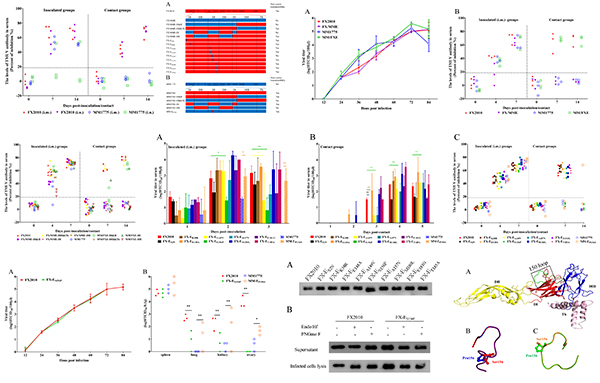Key Molecular Basis of TMUV Transmissibility among Ducks were Found by SHVRI of CAAS
Researchers at Department of Avian Infectious Diseases, Shanghai Veterinary Research Institute (SHVRI) of Chinese Academy of Agricultural Sciences (CAAS) have published a research paper on Journal of Virology about the molecular basis on the pathogenicity of TMUV in Ducks.
Since 2010, novel duck Tembusu virus (TMUV) disease has spread widely in China, causing huge economic losses in the duck breeding industry. TMUV is a member the genus Flavivirus, family Flaviviridae. Duck TMUV, like other zoonotic mosquito-borne flaviviruses such as Japanese encephalitis virus (JEV) and West Nile virus (WNV), can be transmitted vector-independently. To date, why these flaviviruses can be transmitted without mosquito vectors remains poorly understood.
To explore the key molecular basis of TMUV transmissibility, they compared virus replication and transmissibility of an early and a recent TMUV in ducks. The recent TMUV strain FX2010 replicated systemically and transmitted efficiently in ducks while the replication of early strain MM1775 was limited and did not transmit among ducks. They found the TMUV envelope protein and its domain I were responsible for tissue tropism and transmissibility. Further, they prove the mutation S156P in the domain I resulted in disruption of N-linked glycosylation at amino acid 154 of the E protein and changed the conformation of "150 loop" of the E protein, which reduced virus replication in lungs and abrogated transmission in ducks. These data indicate that the 156S in the envelope protein is critical for TMUV tissue tropism and transmissibility in ducks in the absence of mosquitos. The findings provided novel insights on understanding TMUV transmission among ducks. More details are available on the bellow links:
http://jvi.asm.org/content/early/2018/06/07/JVI.00427-18.full.pdf

By Yan Dawei
yandawei865@163.com
-
 Apr 18, 2024Opening Ceremony of the Training Workshop on Wheat Head Scab Resistance Breeding and Pest Control in Africa Held in CAAS
Apr 18, 2024Opening Ceremony of the Training Workshop on Wheat Head Scab Resistance Breeding and Pest Control in Africa Held in CAAS -
 Apr 03, 2024IPPCAAS Co-organized the Training Workshop on Management and Application of Biopesticides in Nepal
Apr 03, 2024IPPCAAS Co-organized the Training Workshop on Management and Application of Biopesticides in Nepal -
 Mar 28, 2024Delegation from the School of Agriculture and Food Science of University College Dublin, Ireland Visit to IAS, CAAS
Mar 28, 2024Delegation from the School of Agriculture and Food Science of University College Dublin, Ireland Visit to IAS, CAAS -
 Mar 25, 2024Director of World Food Prize Foundation visited GSCAAS
Mar 25, 2024Director of World Food Prize Foundation visited GSCAAS -
 Mar 20, 2024Institute of Crop Sciences (ICS) and Syngenta Group Global Seeds Advance Collaborative Research in the Seed Industry
Mar 20, 2024Institute of Crop Sciences (ICS) and Syngenta Group Global Seeds Advance Collaborative Research in the Seed Industry
